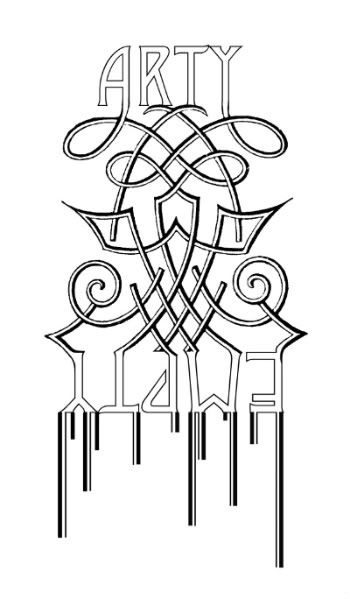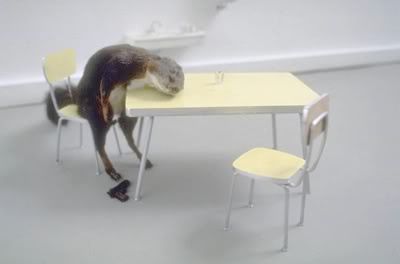En 2002, le groupe islandais Sigur Rós sortait un album intitulé (). Des parenthèses vides qui n’enfermaient rien, pas même un sous-titre. Un album sans titre, « untitled ». Pas vraiment une révolution, les albums éponymes étant nombreux dans l’histoire de la musique contemporaine, mais une nouveauté. L’ouverture d’un espace rempli d’un silence, un blanc, qui s’étalait sur la pochette que rien, pas même le titre des chansons, ne venait altéré. Un album entièrement chanté en « volenska », une langue inventée par le chanteur (pas évident d’ailleurs de différencier l’islandais traditionnel de sa version yaourt « volenskienne »… en tout cas pour une oreille non avertie !). Ils poussèrent même le vice à nous demander de retirer l’autocollant du code barre. Un retour à l’anonymat, un terrain vierge, libre d’interprétations. Un no man’s land agissant comme le miroir de nos envies d’évasion où tout est à redécouvrir au son éthéré et faussement minimal de Sigur Rós.
Cette () musicale tient son équivalent visuel. En effet, des centaines d’œuvres « Sans Titre » pullulent depuis quelques années dans l’art contemporain. Sans forcément faire un historique des œuvres orphelines d’intitulés, on peut seulement rappeler que l’appellation « Sans titre » était réservée à l’origine à des esquisses ou dessins préparatoires peu dignes d’intérêts pour l’artiste ou retrouvés a posteriori. Dans les années 1960, le libellé « Sans titre » prend une toute autre dimension. Les conceptuels décident de s’emparer de ce non-titre afin de justifier un travail fondé sur une esthétique de la dématérialisation et de la pauvreté visuelle. La critique parodique s’incarnait alors parfaitement dans le recours à des images banales, documentaires dont le « sans titre » annihilait tout espoir ou toute volonté de les rattacher à de l’art conventionnel. L’absence de dénomination laissait le spectateur froid, perdu, (isolé dans un désert islandais ?) sans recours. Une situation que nous avons toujours eu du mal à affronter. Par exemple, à la même époque, les Beatles sortaient un de leurs chef-d’œuvres, l’album éponyme de 1968. Il n’a pas fallu longtemps pour que l’on le renomme d’office « album blanc » eu égard à la magnifique pochette de Richard Hamilton. L’absence de mots posés sur un objet effraye car il trouble nos repères. C’était tout simplement l’approche désirée des conceptuels première génération.
Seulement voilà, comme toute bonne idée, elle est rapidement vidée de son sens premier et réappropriée par une longue litanie de suiveurs. Ou de fainéants. Car il est tellement plus facile et rapide de ne plus donner de titre à ses œuvres. Pas d’ouverture, pas de sens caché ou de piste, pas d’orientation, pas de réflexion non plus. Cela permet de multiplier les mêmes œuvres sans en changer la teneur. Cela permet aussi au spectateur de se perdre dans des dédales de « sans titre » dont la date reste la seule indication, obligé de décrire une œuvre pour pouvoir la partager. Comme si cela ne suffisait pas, certains ont osé aller plus loin encore. Intitulant leurs œuvres « sans titre », ils se sentent obligés de rajouter un sous-titre, entre parenthèses, évidemment. Sigur Rós devenant dès lors une sorte de paroxysme conceptuel donnant la leçon à l’art contemporain réfléchi. A quoi servent les parenthèses est-on en droit de se demander ? A se distinguer… sans doute. Quelque peu nostalgique, on peut regretter l’absence de titres qui magnifient parfois l’œuvre, la rende intelligible, la constitue aussi. Autant d’exemples le mélancolique « Bidibidobidiboo » de Maurizio Cattelan, l’ouvert « Self-portrait as Kurt Cobain, as Andy Warhol, as Myra Hindley, as Marilyn Monroe » de Douglas Gordon, le trompeur « 10 portraits photographiques de Christian Boltanski » de, bein, Christian Boltanski, le poétique « Jeune vierge auto-sodomisée par les cornes de sa propre chasteté » de Salvador Dalí ou encore l’explicite « 6 répartitions aléatoires de 4 carrés noirs et blancs d’après les chiffres pairs et impairs du nombre Pi » de François Morellet.
C’est sûr, si, à l’instar de Marlène Mocquet, c’est pour donner des titres tels que « Ils voulaient une seule fleur dans le paysage », « l’arc en ciel humain » ou « les cheveux attrapés par les nuages », autant s’abstenir et laisser un « sans titre » bien plus à propos (ou un titre en volenska ?)…. Attention terrain miné ! On le sait, il est formellement interdit de critiquer nos jeunes artistes français en devenir. C’est un mammifère rare en voie de disparition pour lequel il faut mettre en place tous les dispositifs possibles de conservation, dont l’absence absolue de critique (surtout négative). Pas si difficile à faire puisque la critique française, et internationale d’ailleurs, est morte depuis bien longtemps…. Fin de la parenthèse.
This is not a title.
In 2002, the Icelandic band Sigur Rós released an album titled (). Empty brackets, which locked nothing up, not even a subtitle. An “untitled” album. Not really a revolution, there are plenty of eponymous albums in contemporary musical history, but a new thing. An open space filled up with silence, white spreading all over the cover and nothing, not even song titles came to spoil the whiteness. The entire album was sung in “volenska”, a language the lead singer invented (and let’s just say it’s not that easy for an inexperienced ear to distinguish the traditional Icelandic language from its “volenskian” doggerel version). They’re going so far as to ask for bar code stickers to be removed. A come back to anonymity, a virgin land free from interpretation. A no man’s land acting like a mirror to our escaping wills, a place where everything has to be discovered, accompanied only by the ethereal and wrongfully minimal sound of Sigur Rós.
This musical () has its visual equivalent. Thousands of untitled works have proliferated in contemporary art for years now. We won’t make a list of historically title-orphaned pieces, let’s just remember that the “untitled” label used to be reserved to sketches or uninteresting preliminary drawings or those found a posteriori. During the 1960s, the “untitled” title took a different meaning. Conceptual artists decided to take it as a justification for work based on a dematerialized aesthetic and a weak visual aspect. The parodic critic found an incarnation into trivial images, documentary shoots in which the “untitled” thing annihilated every hope or will to link them to conventional art. This lack of denomination left the spectator cold and lost (alone in the Icelandic desert?), with no way out. A situation we are not used to dealing with. For instance, during the same period, in 1968 precisely, the Beatles released one of their masterworks, the eponymous album. We almost immediately gave it a new name, the “white album” for Richard Hamilton’s beautiful cover. The absence of words on an object left us at a loss because it disturbed our senses. That’s exactly what the first generation of conceptual artists wanted.
Fatally, like any good idea, it quickly turned into something meaningless and embezzled by a litany of me-too artists. Or lazy ones. Obviously, it is easier and quicker to avoid giving titles to one’s works. No opening, no hidden meaning, no lead, no orientation and no thought either. It allows multiplication of the same pieces without changing its content. The spectator is lost into labyrinths of “untitled” artworks, with the date as only indication, having to describe the piece to share it. But some artists have decided to go a little bit further. They give the title “untitled” to their work and add a subtitle, between brackets, of course. So, Sigur Rós becomes a kind of conceptual paroxysm, teaching serious contemporary art a lesson. What on earth might the reason for brackets be? To distinguish from others who’ve also used “untitled”? Nostalgic, we can regret the disappearance of titles that sometimes glorify the work, make it smarter, and make it real too. So many examples such as the melancholic “Bidibidobidiboo” of Maurizio Cattelan, the opened “Self portrait as Kurt Cobain, as Andy Warhol, as Myra Hindley, as Marilyn Monroe” of Douglas Gordon, the misleading “10 photographic portraits of Christian Boltanski” of, well, Christian Boltanski, the poetic “Young virgin self-sodomized by the horns of her own chastity” of Salvador Dali or the explicit “6 random repartitions of 4 white and black squares according to the odd and even figures of the Pi number” of Francois Morellet.
Clearly, if, like Marlene Mocquet, you feel the need to give such titles as “they only wanted one flower into the landscape”, “the human rainbow” or “the hair stuck into the clouds”, please control yourselves. Name your work “untitled” or give it a title in “volenska”…. I know I’m walking on a minefield here. It is so very strictly forbidden to criticize our young French (future) artists. They are rare mammals and an endangered species for which we have to implement all the possible preservation measures and devices, including the absolute interdiction to criticize (particularly those mean negative critics). Not that hard a job given that the French, and international, critics have been dead for a long time now… Brackets closed.



Aucun commentaire:
Enregistrer un commentaire